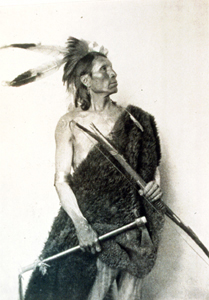by Dick Baker
Triangle Review, 1974

Editor's Note: This article is part of a series of 15 articles which will trace the development of Fort Collins and Loveland through "the elegant '80s." The research was compiled by historian Dick Baker, a retired city official whose grandfather was mayor of Fort Collins.
The historic "Old Grout" (see June 23, 1973, Triangle Review) which had served as sutler's store in Army post days and later as post office, courthouse and community house was razed in 1882 and became the site of Stover's City Drug Store. Many are the stories the old timers told. Once the till did a $1,000 daily business. Mason and Allen, in one order, purchased $11,000 worth of canned goods. In the delicacy of the frontier, cove oysters sold for $2.50 per can. Also, here Billy Patterson administered to a sick Indian a Seidlitz powder in two doses allowing the mixture to effervesce in Poor Lo's stomach, the result of which was a mild Vesuvius. The same Billy also had shampooed one Jim Peyton with a gallon of molasses. The coup de grace was added to the newly finished city hall in the form of a 1,000-pound bell to be seen on display at Grandview Cemetery. A representative residence of that year was the James B. Arthur house which is still standing on the northeast corner of Mulberry and Peterson Streets. The first annual college reunion was held; wooden buildings in the fire limits were prohibited, and fido had to have a dog license. In the third year of "the elegant '80s" we find the starting of Crystal City in Sheep Creek gulch at the foot of Crystal Mountain. Some good ore samples had been found here. Before long, there was a restaurant, livery stable, saloon and two blacksmith shops. That was as far as it got.
Again in '83, there were a great many more fires, especially before the completion of the water works on May 30th. A few of the larger fires: Jan. 26-an attempt to burn down the town by the starting of many fires simultaneously; Feb. 27-Captain Meeds saloon was destroyed; March 7-three fires in one night; April 3-Barkley and Tindall's hardware. Robert's saloon was destroyed on April 7, but not before his stock was nearly all appropriated by thirsty spectators and supposedly volunteer firefighters. Most of these fires were described as a dastardly attempt to burn the town. The comment of one well-known official of the Illinois penitentiary was: "That since his residence here had met no more than 14 men who were inmates of that institution while he was connected with it."
Comments of the time: "Our streets and byways abound in drab shops, gambling hells and houses of ill fame." The 20 inch snow fall that fell Jan. 31 was adjudged by the old timers to be the biggest since '66. Chief Red Cloud, the Ogallala Sioux war chief whose warriors were the scourge of the plain in the '60s and committed so many depredations on the Bozeman Trail, was in Washington D. C., trying to talk the government into remuneration for 7,000 horses he claimed the army took from him. Col. Chivington, who with his Colorado troops had given the Texas confederates at Apache Conona sound thrashing was honored at the old timer's banquet in Denver. The Fort Collins Artesian Well Co. was drilling a well in downtown Loveland from which they obtained a showing of oil at 75 feet, thus creating great excitement.


Preserving the history of Fort Collins, Colorado & the Cache la Poudre region